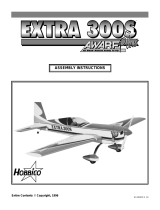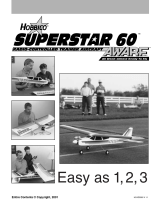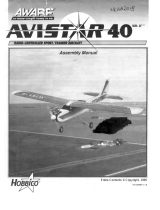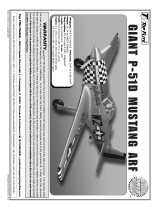Page is loading ...

Surge 400
WARNING
A radio-controlled model is not a toy and is not intended for persons under 16 years old. Keep
this kit out of the reach of younger children, as it contains parts that could be dangerous. A radio-
controlled model is capable of causing serious bodily injury and property damage. It is the buyer's
responsibility to assemble this aircraft correctly and to properly install the motor, radio, and all other
equipment. Test and fly the finished model only in the presence and with the assistance of another
experienced R/C flyer. The model must always be operated and flown using great care and common
sense, as well as in accordance with the Safety Code of the Academy of Model Aeronautics (5151
Memorial Drive, Muncie, IN 47302, 1-800-435-9262). We suggest you join the AMA and become prop-
erly insured prior to flying this model. Also, consult with the AMA or your local hobby dealer to find an
experienced instructor in your area. Per the Federal Communications Commission, you are required
to use only those radio frequencies specified "for Model Aircraft."
LIMITED WARRANTY
Carl Goldberg Products, Ltd. has inspected and certified the components of this aircraft. The company urges the buyer to perform
his own inspection, prior to assembly, and to immediately request a replacement of any parts he believes to be defective for their
intended use. The company warrants replacement of any such components, provided the buyer requests such replacement with-
in a period of 10 days from the date of purchase and provided the defective part is returned, if so requested by the company.
No other warranty, expressed or implied, is made by the company with respect to this kit. The buyer acknowledges and under-
stands that it is his responsibility to carefully assemble the finished flying model airplane and to fly it safely. The buyer hereby
assumes full responsibility for the risk and all liability for personal or property damage or injury arising out of the buyer's use of the
components of this kit.
CARL GOLDBERG PRODUCTS, LTD.
P.O. Box 818 Oakwood GA 30566 Phone #678-450-0085 Fax # 770-532-2163 www.carlgoldbergproducts.com

2
USING THIS INSTRUCTION MANUAL
Before you begin assembling your Surge 400 ARF, take
some time to read through this entire instruction book. It is
designed to take you step-by-step through the process and
to give you added information on motor and radio selection
and set-up, balancing your aircraft, and flying your model.
The time you spend will speed the assembly process and
help you avoid problems.
PREPARING FOR ASSEMBLY
You will need a work area of approximately 24 x 48" which has
been covered to protect it from adhesive, as well as cuts and
other damage. Many people cover their work area with a
sheet of dry wall (sheet rock) and/or waxed paper t o pre-
vent CAGlue and Epoxy from ruining the work surface.
CONSTRUCTION TIPS
IMPORTANT: ALWAYS READ A FEW STEPS AHEAD.
This will alert you to coming instructions and will help you
plan accordingly.
Do not hesitate to ask questions. Your local hobby dealer
and area flyers will most likely be happy to help, as they
want you to have a successful flying experience.
ADHESIVES & GLUING TECHNIQUES
CA adhesives are specially formulated to firmly glue the
plywood, hardwood, and balsa used in your model and to
withstand the vibration and stresses of high performance
flight. However, there are times, such as when you are
installing the stabilizer and fin on the fuselage and want
more set-up time for careful alignment and positioning,
then you should use epoxy. Occasionally, you also will
want to use thin CA, which "wicks" into the surrounding
areas. Aliphatic resin glue or similar water-based glues can
also be used, but they will add to the assembly time
because they dry so much more slowly than CA glue.
Remember, when ever using any CA, you must be careful
to read instructions thoroughly, as you will have only sec-
onds for positioning of parts. Be sure to trial fit parts
together before gluing. Also, never use watery THIN type
CA glue for gluing plywood and hardwood parts. Thin CA's
do not adequately bond these areas.
CAUTION
Some people may experience an allergic reaction when
exposed to fumes from CA glue or epoxy. As with paints,
thinners, and solvents, it is always important to use glues
only where there is adequate ventilation to carry fumes
away. A fan is recommended. Also, special care must be
taken when using CA, as it will bond skin as well as other
surfaces. Before using any CA, carefully read all label pre-
cautions. When using CA, protective eye-wear and care in
keeping the glue away from the face is highly recommend-
ed. If CA does happen to get into the eye, hold lid open
and flush with water only. Seek immediate medical atten-
tion.
COVERING
The Surge 400 ARF is covered in a polyester film chosen
for its beauty, toughness, and ease of application and
repair. It is not uncommon for ARF's to develop a few wrin-
kles in transit. If this is true of your model, the situation is
easily corrected. Before you begin putting the pieces
together, run around the edge of the seams first then over
the surface of each section with an iron (either specially
designed for airplane use or the more cumbersome house-
hold iron). Apply the heat (set at about 350° F), following
along with a soft cloth and pressing down on the covering
as you go around. This will more firmly set the covering
adhesive into the wood and keep your aircraft covering
tight and smooth in the future. Once you have ironed the
seams keep heat away or the seams will separate when
you try to shrink the middle. If this happens the wrinkles will
not come out of the covering.
This is not a beginners airplane.
This booklet assumes you have
modeling experience.

3
ITEMS NEEDED TO COMPLETE THIS AIRCRAFT
* 1 5 CHANNEL RADIO WITH 6 MICRO SER-
VOS. (WE USED 6 CHANNEL FUTABA
RADIO WITH S3108 SERVOS AND GREAT
PLANES ELECTRICFLY RECEIVER W/O
SPEED CONTROL)
* 2 6” SERVO “Y” HARNESS
* 2 6” SERVO EXTENSIONS
*
2 12” SERVO EXTENSIONS
* 1 ELECTRONIC SPEED CONTROL (WE
USED A CASTLE CREATIONS PHOENIX
25 BRUSHLESS SPEED CONTROL)
*
1 3 CELL LI-PO BATTERY (GREAT PLANES
ELECTRICFLY 1500)
*
1 ULTRAFLY BRUSHLESS MOTOR A/30/29
WITH 3.89 GEAR RATIO
*
1 GREAT PLANES ELECTRIFLY PROP
ADAPTER 3MM APC LONG
*
1 APC PROPELLER 9 X4.7 SLO FLYER
*
1 CA ACCELERATOR
* 1 1 OZ. BOTTLE CA MEDIUM GLUE
*
1 1/2 OZ. BOTTLE CA THIN GLUE
* 1 5 MINUET EPOXY
*
1 1/4” FOAM RUBBER
* 1 #2 X 1/4” SHEET METAL SCREW FOR
MOTOR(MIGHT BE REQUIRED FOR SOME
MOTOR INSTALLATIONS)
TOOLS AND SUPPLIES FOR ASSEMBLY.
* MODELING OR UTILITY KNIFE
* WORK SURFACE (24" X48")
*
SMALL STANDARD & PHILLIPS SCREW-
DRIVERS
* MASKING TAPE
* NEEDLE NOSE PLIERS
* 24” RULER
*
FLEXIBLE STRAIGHT-EDGE
*
30-60-90° x 6" TRIANGLE
* SOFT PENCIL
* A FEW STRAIGHT OR "T" PINS
*
WIRE CUTTER (DYKES)
* OPTIONAL HEAT GUN/COVERING IRON
* ACID BRUSH
* 5 FT. LENGTH OF STRING
Caution:
Before starting, care-
fully go over all high
stress areas (Wing
bolt mounting blocks,
Firewall,etc.) with an
epoxy or wood glue to
confirm all areas are
well glued.

4
Installing Ailerons & Flaps
1. * Collect the following parts:
(1) Wing
(2) Ailerons ( Left & Right)
(2) Flaps ( Left & Right)
(10) Mini CA hinges
1. * Locate the pre-cut aileron and flap hinge slots
in both sides of the wing. Using a hobby knife
(#11 blade), slide the blade into each slot to
make sure it is cleanly cut.
* Repeat this process with the ailerons and
flaps, making sure all hinge slots are clean.
2.
* Find the control horn slot near one end of the
aileron.
* Align the slot in the aileron with the servo hole
in the wing.
* Insert the mini CA hinges half way into the
wing and the ailerons. (Use a pin inserted into
the middle of the hinge to help keep the hinge
in the middle.)
* Repeat steps 1 & 2 for the flap.
* Make sure that the aileron is tight against the
wing and even with the wing tip.
* Insert a piece of thin card board stock
between the flap and aileron to allow a space
for movement.
* Using thin CA glue, place one drop on all
hinges top and bottom.
1. * Gather the following items:
(2) 6" Servo Extension wires
(2) 12" Servo Extension wires
(1) Wing
(4) Servos
(1) Electrical tape
2. * Plug one 12" extension wire into a aileron
servo.
IMPORTANT! To ensure that any connections located
inside the wing will not come loose, either when the
wires are pulled, or during flying, always tape them
securely together with electrical tape.
Servo Extensions
3. * Tie or tape the aileron extension wire end to
the string that is exiting the outer aileron servo
hole in the bottom of the wing.
*
Push the extension in the servo hole, SLOW-
LY pull until the end of the 12" extension
comes out of the hole in the center of the
wing.
* Tape the extension securely to the wing, so
that it will not slide back in while you are work-
ing.
* Mount the aileron servo using the hardware
provided by the radio manufacture.
4. * Repeat steps 2 & 3 for the other aileron servo.
5. * Using the 6” servo extensions, tape the
extensions to the flap servos and pull the
extensions to the center of the wing just like
you did the aileron servos.

5
2. * Remove the covering on both the ailerons &
the flaps, where the control horn slots are
located.
* Using CA glue, attach the control horns to the
ailerons and flaps.
3.
* Find the small aileron pushrod wire, and place
a “z” in one end.
1. * Collect the following parts:
(1) Wing
(4) Control Horns
(4) EZ connectors with screws and nylon nuts.
(4) Short Pushrod Wires
Flap & Aileron Pushrods
4. * Connect the EZ pushrod connector to the
Control horn.
*
Put the “Z” bend into the outer hole of the
servo arm.
*
Slide the pushrod wire through the connector
on the control horn and mount the arm onto
the servo.
* Tighten the set screw onto the pushrod.
5. * Repeat these steps for the other aileron and
flap pushrods.
Snap Nut
Set Screw
Stabilizer
1. *
Collect the following parts:
(1) Fuselage
(1) Stabilizer & Elevator
(1) wing
(1) 4-40 x 3/4” Socket Head Bolt
(1) #4 Washer
2. * Locate the hole in the center of the wing for
the wing bolt. Remove the covering over the
hole.
*
Using the 4-40 x 3/4” socket head screw and
the #4 Washer, bolt the wing to the fuselage.
3. * Find the center of the stabilizer, by measuring
the length of the trailing edge where the ele-
vator hinge line is located.
* Stand the stabilizer up on its edge and using a
right triangle draw a center line up from the
trailing edge to the leading edge.
* Find the center of the fuselage in front of
where the stabilizer sits.
* Place the stabilizer on the fuselage using the
marks you just made.

6
“X”
“X”
4. *
Measure from the end of the wing to the tip of
the stab. This measurement should be the
same for both sides.
* Mark the stabilizer where it rest on the fuse-
lage
*
Remove the covering where the stab will be
glued to the fuselage.
* Look down the length of the fuselage and
check that the stabilizer is parallel to the wing.
If it is not then shim the low side till they are
parallel.
* When satisfied then glue the stabilizer in place
using 5 minuet epoxy. Make sure the stabiliz-
er remains both perpendicular and parallel to
the wing and fuselage while the epoxy dries.
Elevator Control Horn
1. * Collect the following parts:
(1) Fuselage With Stabilizer
(2) Elevator
(1) EZ connector complete
(1) Nylon Control Horn
(1) Long Pushrod Wire
2. * Locate the slot in one side of the elevators
near the center.
* Remove the covering over the slot.
* Glue the Nylon control horn into the slot mak-
ing sure that the elevator is placed on the
work bench as shown in the previous picture.
3.
* Take the long wire pushrod and insert the end
into the pushrod tubing inside the fuselage
next to the servo tray.
* Attach the EZ connector to the control horn
with the adjusting screw facing out.
* Push the elevator pushrod through the EZ
connector and snug the set screw to hold the
pushrod in place.
Bottom of Elevator
Fin & Rudder Installation
1. * Collect the following parts:
(1) Fuselage With Stabilizer
(1) Fin & Rudder
(1) EZ connector complete
(1) Nylon Control Horn
(1) Long Pushrod Wire
2. *
Insert the fin into the fuselage slot.
*
Mark where the fuselage meets the fin.
* Remove the fin from the fuselage.
* Carefully cut the covering off the fin where the
fin will be glued to the fuselage.
* Glue the fin to the fuselage making sure to
keep the fin perpendicular to the stabilizer.

7
2. * Locate the slot in the rudder near the bottom.
* Remove the covering over the slot.
* Attach the EZ connector to the control horn
with the adjusting screw facing down.
* Glue the Nylon control horn into the slot mak-
ing sure that the rudder control horn is on the
opposite side from the elevator control horn.
3.
* Take the long wire pushrod and insert the end
into the pushrod tubing inside the fuselage
next to the servo tray.
* Push the rudder pushrod through the EZ con-
nector and snug the set screw to hold the
pushrod in place
Landing Gear
1. * Collect the following parts:
(1) Fuselage
(1) Main Landing Gear Wire
(1) 4-40 x 1/2” Socket Head Screw
(1) #4 Washer
(2) Wheels
(2) Nylon Wheel retainers
2. * Remove the hatch from the bottom of the
fuselage
* Insert the landing gear into the slot just behind
the hatch opening.
*
Using the 4-40 Socket head screw and wash-
er, insert the screw into the hole and tighten.
3. * Place the wheel onto the wire and hold it in
place by inserting the Nylon retainer on the
end.
*
Place a drop of glue on the end of the wire to
hold the retainer in place.
Tail Skid
1. * Collect the following parts:
(1) Fuselage
(1) Tail Skid
2. * Insert the wire exiting the bottom of the tail
skid into the hole in the bottom of the fuse-
lage.
* Glue the tail skid onto the bottom of the fuse-
lage.

8
Installing Motor & ESC
1. * Collect the following parts:
(1) Fuselage
(1) Motor with Gear Drive (Not Included)
(1) Electronic Speed Control (Not Included)
(1) Screw for motor installation (Not Included)
Note:
Read the instructions that come with your
motor and speed control for proper wiring.
Your Motor and Speed Control might be dif-
ferent than shown. You might want to solder
the speed control to the motor after thread-
ing the wire through the firewall.
2. *
We have assembled the motor and gear drive
that was provided with the Ultrafly system by
the manufactures instructions.
* Slide the motor and gear drive onto the motor
stick making sure that the back of the prop
does not touch the fuselage sides.
* Screw the gear drive to the motor stick.
Caution:
Do Not
leave the propeller on the motor at
this time. Electric motors can start turning
at any time during radio installation. This
can cause damage to the plane or bodily
harm.
3. * Insert the motor wires through the holes in the
firewall.
Note:
You might have to enlarge the holes in the
firewall for the speed control to fit through.
3. * Insert the speed control receiver wire through
the hole next to the landing gear.
3. * Gently pull the wire through the former and
into the radio compartment..

9
2. * Mount the elevator and rudder servo as
shown above.
*
Attach the pushrods to the servo arms the
same way you did the aileron servos.
* Mount the two servo arms to the top of the
servos.
Radio Installation
1. * Collect the following parts:
(1) Fuselage
(2) Micro Servos with Hardware (Not Included)
(1) Micro Receiver (Not Included)
(2) Servo “Y” Harness (Not Included)
3. * Plug the elevator and rudder servos into your
receiver.
* Attach the “Y” harness to the receiver.
* Plug in the speed control.
* Cut foam and wrap around the receiver.
4. * Put the receiver wrapped in foam in front of
the servos.
* Drill a hole for the receiver antenna wire in the
bottom of the fuselage.
* Tape the receiver wire end to the bottom of the
fuselage at the tail.
1. * Collect the following parts:
(1) Fuselage
(1) 3 cell Li-Po Battery
Battery Installation
* Insert foam into the front battery compart-
ment.
* Slide the Li-Po battery into the front compart-
ment.
* Cut a hole in the covering in the bottom hatch
to allow heat from the battery to escape.
Hole
Control Set Up
Turn on your transmitter and plug in the receiver
battery. Center all the control surfaces (rudder,
elevator & aileron). If required by your speed
control this is the time to program it for your
use.
Control Travel
Aileron up / down 1” to 1-1/4”
Elevator up / down 1/2” to 3/4”
Rudder Right / Left 1”
Flap Down 1” to 2”
Propeller
Install the prop adapter and your propeller at
this time. We used a 9 x 4.7 APC prop for our
motor, battery and speed control setup.
Caution:
The propeller can start turning any
time the receiver battery is plugged
in.
Balancing
Your model should balance 2-1/2” back from
the leading edge of the wing next to
the fuselage.
/



